
This article relates to the flora of New Zealand, especially indigenous strains. New Zealand's geographical isolation has meant the country has developed a unique variety of native flora. However, human migration has led to the importation of many other plants as well as widespread damage to the indigenous flora, especially after the advent of European colonisation, due to the combined efforts of farmers and specialised societies dedicated to importing European plants & animals.

Ōkārito Lagoon is a coastal lagoon on the West Coast of New Zealand's South Island. It is located 130 kilometres (81 mi) south of Hokitika, and covers an area of about 3,240 hectares (12.5 sq mi), making it the largest unmodified coastal wetland in New Zealand. It preserves a sequence of vegetation types from mature rimu forest through mānuka scrub to brackish water that has been lost in much of the rest of the West Coast. The settlement of Ōkārito is at the southern end of the lagoon.
Ribbonwood is a common name for several plants. They are like the lacebarks in having an inner layer of bark made up many lace-like layers, which can be torn into ribbon-like strips, and may refer to:

Hoheria is a genus of six species of flowering plants in the family Malvaceae. All are endemic to New Zealand. The genus name is a latinization of the Māori language name, houhere. That name, as well as lacebark and ribbonwood, are often used as common names. The name lacebark comes from the lace-like fibrous inner bark layer.

The Opotoru River is a river of the Waikato Region of New Zealand's North Island. It flows north, reaching the Raglan Harbour southwest of the town of Raglan. There is no regular monitoring of pollution, but 38 kilometres (24 mi) (31.2%) of the river has been fenced to protect it from farm stock.
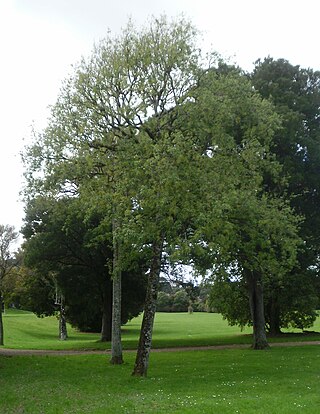
Plagianthus regius or lowland ribbonwood is a tree that is endemic to New Zealand. The common name is simply ribbonwood. The Māori name is mānatu but it is also known as manaui mānatu.
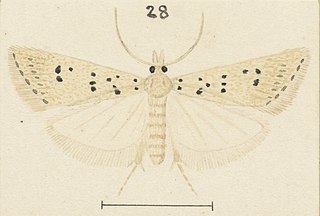
Heterocrossa maculosa is a species of moth in the family Carposinidae. It is endemic to New Zealand and has been found in the southern half of the South Island. Larvae feed on Hoheria angustifolia and Plagianthus regius. Adults are on the wing from November to January. This species is classified as "Data Deficient" by the Department of Conservation.
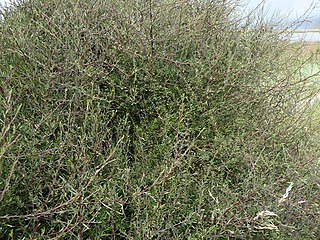
Plagianthus divaricatus or saltmarsh ribbonwood is a plant that is endemic to New Zealand. The Māori name is makaka. Other common names it is known by marsh ribbonwood, Houi and Runa.
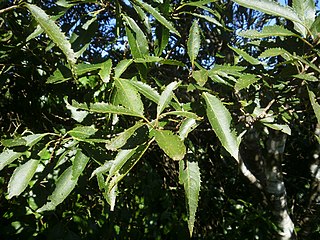
Hoheria sexstylosa, the long-leaved lacebark or ribbonwood, is a species of flowering plant in the family Malvaceae, endemic to New Zealand. It is an evergreen tree or shrub growing to 8 m (26 ft) tall by 6 m (20 ft) broad with glossy green leaves, and white flowers in summer and autumn. The Latin specific epithet sexstylosa means "six styles".

Parsonsia heterophylla, commonly called New Zealand jasmine or kaihua, is a climbing plant endemic to New Zealand. It was first described by Alan Cunningham in 1839.

Hoheria glabrata, the mountain lacebark or ribbonwood, is a species of flowering plant in the family Malvaceae, endemic to New Zealand. It is one of the few deciduous trees to be found in N.Z. growing to 10 m (33 ft) tall with green leaves that turn yellow in autumn, and white flowers that appear around January.

Hoheria populnea, commonly known as New Zealand mallow, lacebark or houhere, is a species of flowering plant in the family Malvaceae, endemic to New Zealand.

Epiphryne undosata, also known as the lacebark looper, is a moth of the family Geometridae. It is endemic to New Zealand and is found on both the North and South Islands. It inhabits native forest. The larvae feed on plant species in the genera Hoheria and Plagianthus. They pupate amongst dead leaves in a silk cocoon. The adult moths have been observed on the wing all year round but are most commonly seen from November until February. The adult moths are extremely variable in both their colour intensity and wing pattern.

Anisoplaca acrodactyla is a species of moth of the family Gelechiidae. It was described by Edward Meyrick in 1907 and is endemic to New Zealand. This species has been observed in South Island as well as in the North Island. Larvae feed on species in the genera Hoheria and Plagianthus including the species Plagianthus regius'.

Plagianthus is a genus of flowering plants confined to New Zealand and the Chatham Islands. The familial placement of the genus was controversial for many years, but modern genetic studies show it definitely belongs in the Malvaceae subfamily Malvoideae. The name means "slanted flowers".

Dracophyllum arboreum, commonly known as Chatham Island grass tree and tarahinau (Moriori), is a species of tree in the heath family Ericaceae. Endemic to the Chatham Islands of New Zealand, it reaches a height of 18 m (60 ft) and has leaves that differ between the juvenile and adult forms.

Cyclocybe parasitica, also known as tawaka in Māori language or poplar mushroom, is a species of gilled mushroom in the genus Cyclocybe found mostly in New Zealand and Australia. It grows on native and introduced trees where it can cause heart rot, and does not seem to be associated with conifers.

Hoherius meinertzhageni, the ribbonwood fungus weevil, is an endemic New Zealand beetle that has been recorded feeding on the ribbonwood species Plagianthus regius and Plagianthus divaricatus and the mountain lacebark, Hoheria glabrata.
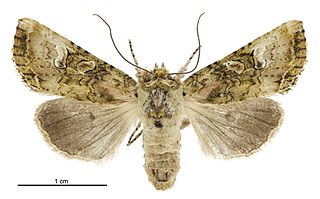
Meterana levis is a species of moth in the family Noctuidae. This species is endemic to New Zealand.
This page is based on this
Wikipedia article Text is available under the
CC BY-SA 4.0 license; additional terms may apply.
Images, videos and audio are available under their respective licenses.
















